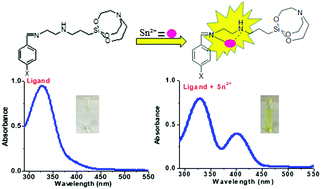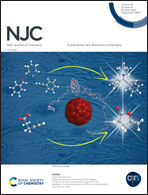Designing the recognition of Sn2+ ions and antioxidants: N-heterocyclic organosilatranes and their magnetic nanocomposites†
Abstract
This article presents the design and synthesis of a new series of N-heterocyclic unsymmetrical organosilatranes starting from carboxaldehydes and [3-(2-aminoethylamino)propyl]trimethoxysilane. The molecular structures of the desired organosilatranes were confirmed by various characterization techniques such as elemental analysis, FTIR, NMR (1H and 13C) and mass spectroscopy. The prepared compounds were evaluated for their cationic chemosensing activities and the recognition studies show considerable variations in the intensity and λmax values of absorption and emission spectra on addition of Sn2+ ions. Further immobilization of N-heterocyclic unsymmetrical organosilatranes was done on a magnetic silica surface and the resultant nanohybrids were identified by numerous analytical techniques viz., FTIR, TGA, XRD, SEM, VSM and BET. The comparative detection studies of the nanoparticles with silatranes showed better Sn2+ ion binding ability. Moreover, the pharmacokinetic profile of the synthesized compounds was analysed using MOLINSPIRATION and ADMET software and it gave auspicious results that triggered the investigation of the cytotoxicity and total antioxidant activity (TAA) of these molecules.



 Please wait while we load your content...
Please wait while we load your content...